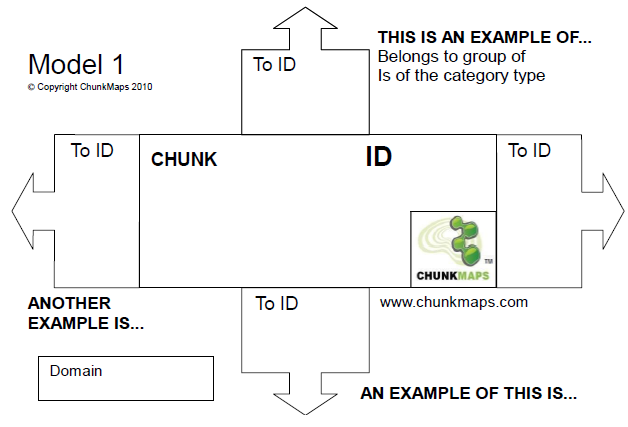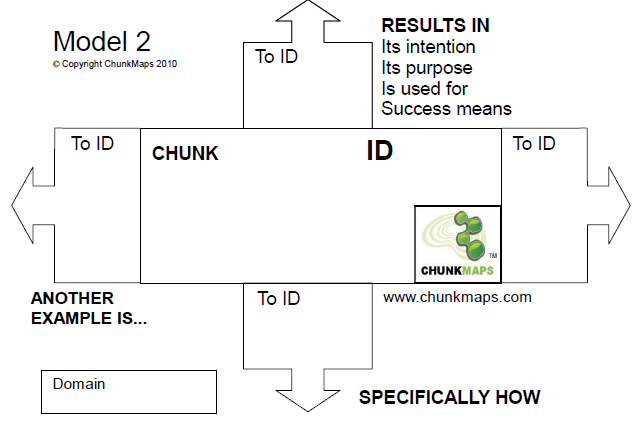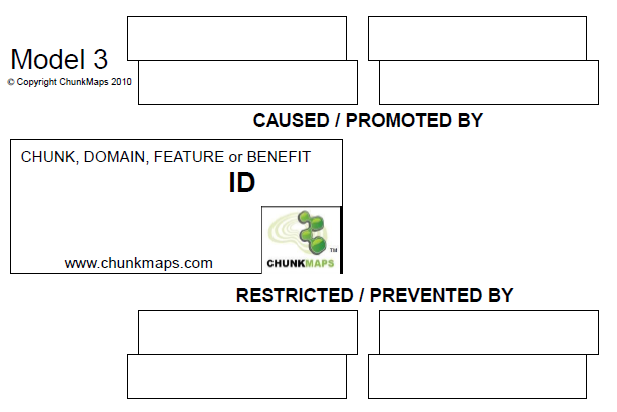
The 4 CHUNKMAP Models
Tony Nudd BA MSc

Tony Nudd BA MSc
The CHUNKMAPS method has a number of very simple rules which bring about powerful information processing and creativity.
The rules have been grouped into 4 Models.
Each model delivers its own special outcomes, and when all 4 Models are executed together real empowerment takes place.
 MODEL 1 - The Definition Model
MODEL 1 - The Definition Model

The Definition Model is useful for determining the definitive logical place for the Chunks in the physical world.
Model 1 answers the Chubk-Up: "This chunk is an example of what?", "This chubk belongs to the category of which type?"
Model 1 answers the Chuunk-Down: "An example of this chunk is?"
Model 1 also presents te Chunk-Across: "Another exaple of this is?"
It is recommended you use Model 1 first on your chunks to understand where the chunk fits into the logical hierarchy of the human world.
 MODEL 2 - The Interaction Model
MODEL 2 - The Interaction Model

The Interaction Model is useful for determining what interactions the chunk makes.
Model 2 answers the Chunk-Up: "Theis chunk results in?, Its intention is?, It's used for?, Success would mean?
Model 2 answers the Chunk-Down: "Specifically how?"
Model 2 also presnts the Chunk-Across: "Another example of this is?"
Use Model 2 on your chunks to understand the interactions your chunk has with other chunks.
Using this model after Model 1 will bring deeper understanding of you chunks.
Use the results from Model 2 in Models 3 and 4 (below) this will lead to further creativity and new insights into your chunks.
 MODEL 3 - The Environment Model
MODEL 3 - The Environment Model
The Environment Model is useful for determining:

CAUSED/PROMOTED BY - Model 3 encourages you determine what influences your Chunk positively. E.g. Bringing Food through the airport from overseas is caused by "unavailability of that food locally".
RESTRICTED/PREVENTED BY - Model 3 encourages you to determine what influences your Chunk negatively. E.g. Bringing Food through the airport from overseas is prevented through "fines and penalties"
 MODEL 4 - The Features Model
MODEL 4 - The Features Model
The Features Model is useful for determining:

FEATURES/ATTRIBUTES - Model 4 encourages you determine what Features and/or Attributes (or emotions) your Chunk has. E.g. A Mobile Phone may have the Feature of a "Touch Screen".
BENEFIT/OBJECTION - Model 4 encourages you determine what Benefits or Objections that Feature/Attribute may produce. E.g. A "Touch Screen" on a Mobile Phone has the benefit of "Smaller Size" but an objection of "Increases selecting wrong characters"
Learning to identify the what "Promotes & Restricts" your Chunks and what your Chunk's "Features & Benefits" are allows you to create powerful and compelling arguments which you can incorporate into your Journey of Persuasion in order to influence your audience.
INCORPORTATING THE MODELS
Enriching your chunks by incorporating all the Models into your Chunk Maps work will dramatically assist your ability to create a powerful Journey of Persuasion. The diagram below represents your Chunk, incorporating all 4 Models.
Typically at a given start chunk (e.g. the start of a new paragraph in your essay, a new slide in your presentation etc) you would chunk-up to get agreement and common understanding from your audience.
Then you would chunk-down to more detailed chunks of information to verify your arguments.
Chunk Across to show similar examples to re-enforce your information for chosen chunks.
This typical Journey of Persuaion and the use of the associated chunks (chunk up, chunk down, chunk across) is shown in the diagram below. Note that each chunk is defined by the use of all four models.
In my playbook, we will explore this concept of the '4-ChunkMap Models' further and apply it to AI Prompting and harness the power of Generative-AI